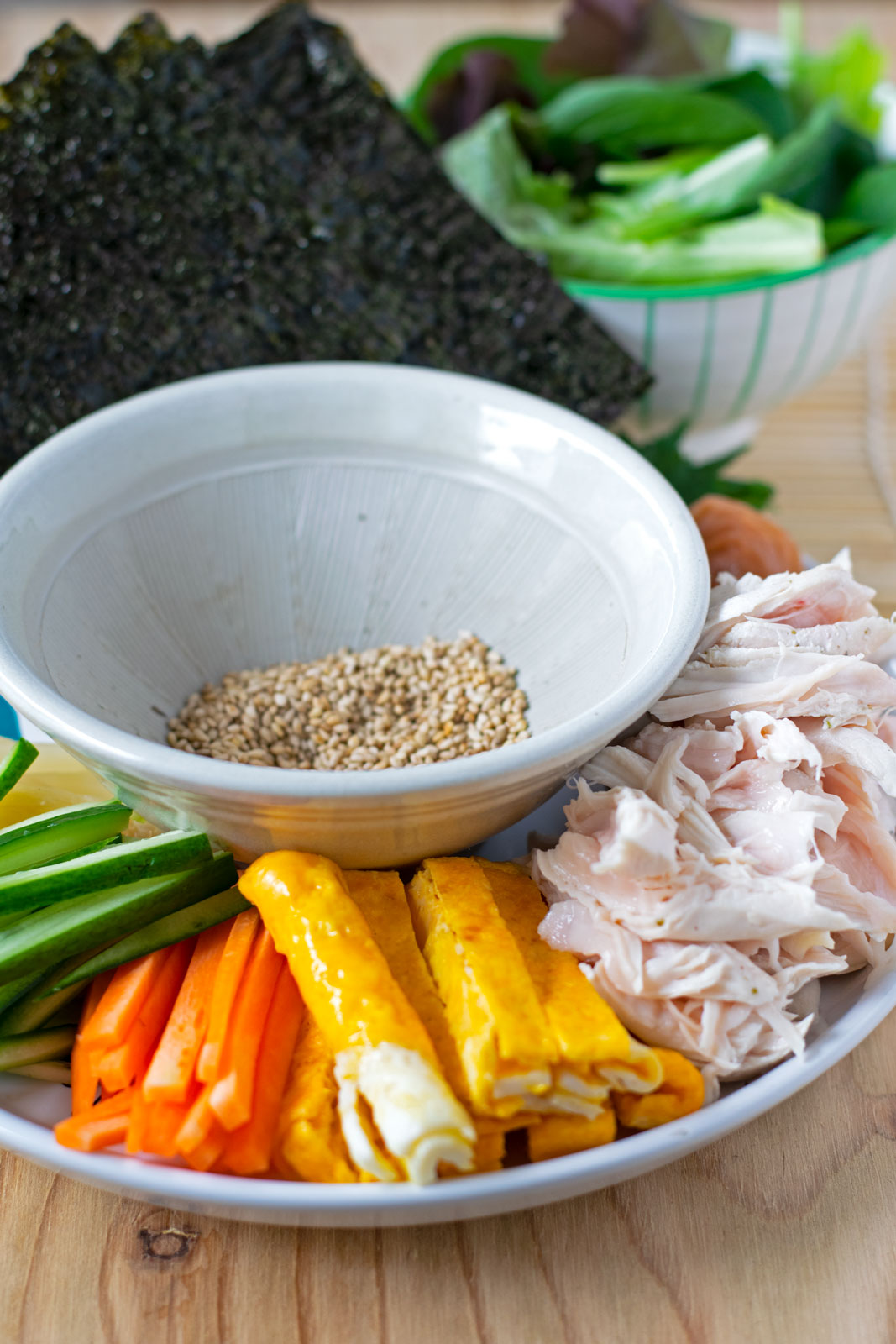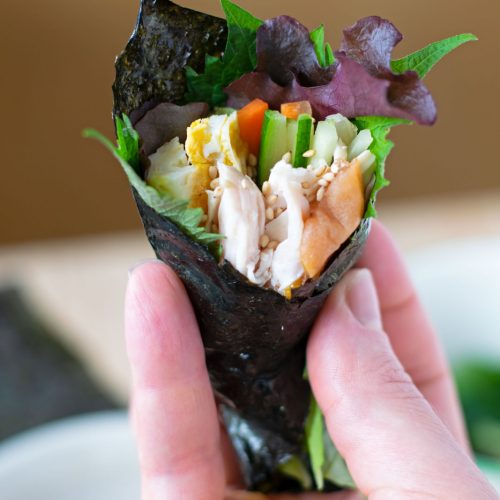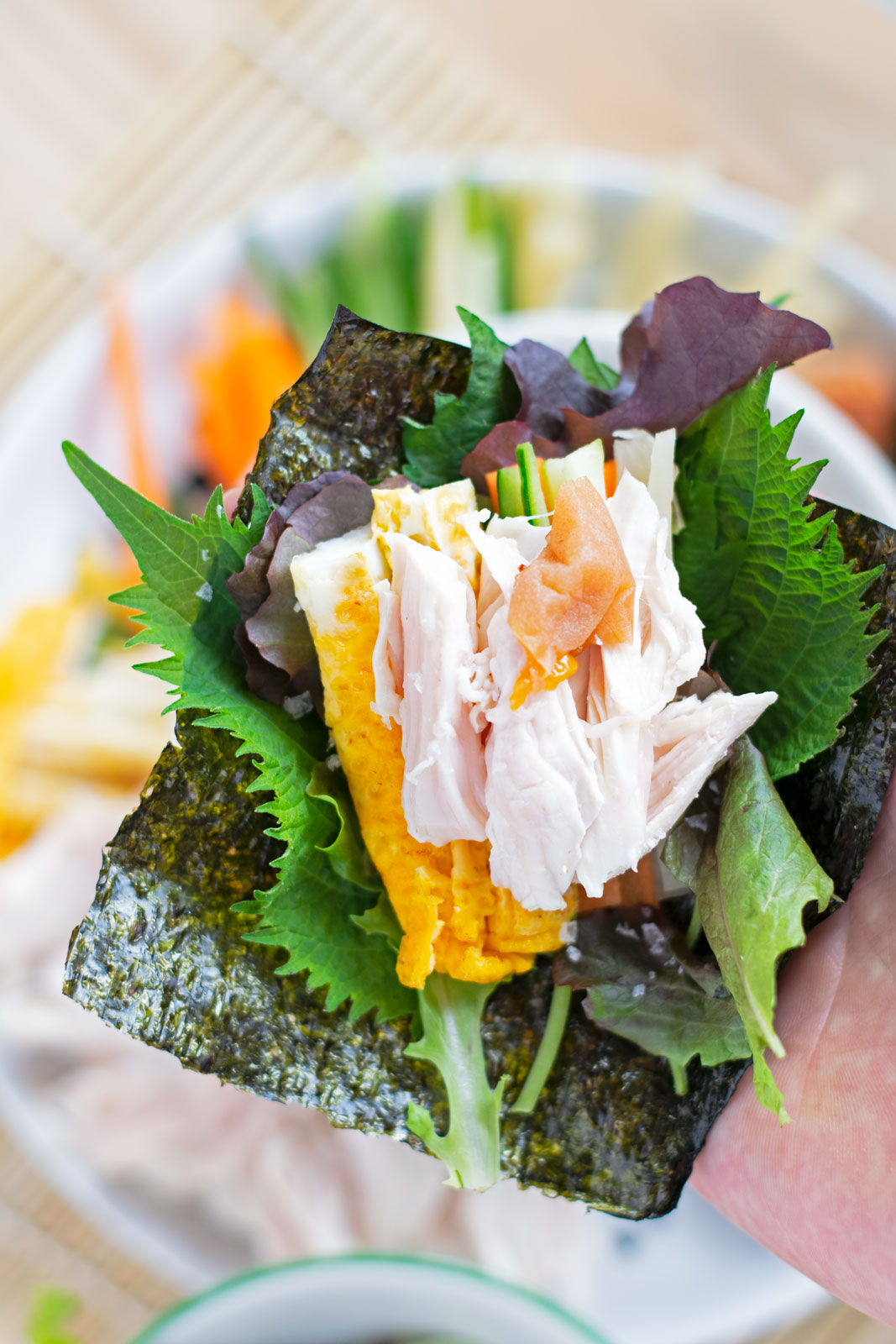Inspired by sushi rolls, I recreated seaweed wraps without the raw fish or rice. In Japanese, these "hand rolls" could be called stamina temaki-zushi (スタミ手巻き寿司). If you want to lose weight and still eat good tasting food that fills you up, "this is how I roll!" 🎶
Jump to Recipe
What is a seaweed wrap?
If you just googled it, you probably noticed that there are two very distinct meanings of your search term 'seaweed wrap'.
One is a fancy spa treatment where your body is completely covered in a paste made from powdered seaweed. Then you get wrapped up so you sweat all those no-good toxins out through you pores, in theory. Ahh, how good would that feel right about now!
The second meaning, the one I'm talking about, is the edible version. It’s basically a Japanese or Korean seaweed-as-tortilla burrito, or in this case, a bite-sized taco. The literal translation from Japanese is 'seaweed roll'.
Various raw or cooked fillings, typically with white rice, are rolled up inside a single sheet of seaweed.

What is a seaweed wrap called?
In Japanese, a seaweed wrap is called maki-zushi, literally rolled sushi. The other commonly used term is nori-maki or seaweed roll. Traditionally, these are filled with raw fish, with or without finely sliced vegetables, and wrapped in a sheet of dried nori seaweed.
In Korean, it’s called gimbap.
Norimaki vs. Gimbap
There are two main differences between gimbap and norimaki. First, the seaweed for gimbap is lightly seasoned with sesame seed oil. The seaweed for norimaki is not flavored.
And second, the fillings in gimbap are stronger and richer in taste, and sometimes spicy. The only spicy ingredient that goes with norimaki is wasabi. Beef bulgogi, BBQ pork are two of the most common filling in gimbap, plus a variety of julienne-sliced fresh or pickled vegetables.

Is a seaweed sushi wrap good for you?
Yes, but it depends on two factors: the quality of your seaweed and what your fillings are.
The Americanized version of sushi wraps tend to not be as healthy. Especially the ones with tempura fried filling and mayonnaise.
I’ve also tried Korean cheese-filled seaweed rolls. Again, maybe not so healthy but tasted amazing.
The picture below will give you an idea of healthy fillings to put in your seaweed wrap. My aim was to include a rainbow of vegetables, mostly fresh, some pickled, with some protein.

How to make seaweed wraps (hand-rolls)
Originally, I thought I'd use a bamboo mat, called makisu (巻き簾) in Japanese or gimbal (김발) in Korean. A bamboo sushi rolling mat is needed make those long cylinder-shaped rolls that you cut into into pieces.
My intention was to make seaweed wraps without sushi rice. I ran into an obstacle. Without the rice, my rolls wouldn't stick together properly. That's when I decided making hand rolls was a much more feasible option. I abandoned my bamboo mat idea and rolled these in my hand.
Rather than making seaweed wraps with full-sized sheets of seaweed, I used ¼ sized squares, the typical size for hand-rolls.
All I had to do was put the seaweed square on the palm of my hand, add the right amount of fillings, and roll it up by hand.
If you want to learn how to make traditional sushi rolls, here is a recipe by Pickledplum.com.
Tips for making nori hand-rolls
- First, know that making these hand-rolls is very easy. No special Japanese kitchen tools or bamboo mat is needed.
- Dried nori seaweed loses its crispness quickly when in contact with air. Keep it stored in an air-tight package until you are ready to eat.
- After cutting full sheets of dried seaweed into quarters (¼ squares), immediately store them back in the original air-tight package or Ziplock bag.
- Put out 10 or fewer squares of dried seaweed at a time and replenish as needed.
- Besides that, there's no wrong way to wrap up your fillings. I prefer to add the leafy greens, followed by other sliced vegetables and then the protein last.
- If you add too many fillings, it just makes it hard to wrap up. You'll learn fast!


Seaweed Wrap (Protein - Low Carb)
Ingredients
- 2-3 sheets nori dried seaweed
- 1 chicken breast small
- 1 egg
- 2-3 cups mixed greens
- 6-8 shiso leaves
- ½ carrot small
- ½ cucumber
- 1 umeboshi pickled plum
- takuan pickled daikon radish
Instructions
Nori Seaweed Prep
- Cut full sheets of nori into quarters with a sharp knife and cutting board or kitchen scissors.
- Seal the squares of nori in a ziplock bag with air removed or the original package, sealed to keep them crisp.
Boiled Chicken
- Bring water to a boil in a pan.
- Once water becomes to a boil, add the chicken.
- Turn down the heat to a light boil. Boil chicken for 4-5 minutes or until cooked through.
- Remove chicken from the pan with a fork. Let it cool on a cutting board or bowl.
- Once the chicken has cooled, peel apart into small pieces with your fingers and set aside.
Tamagoyaki
- Melt butter in a tamagoyaki pan on low heat.
- See my tamagoyaki post/video for more detailed instructions.
Fillings Prep
- Cut takuan (pickled radish), cucumber, and carrots into thin julienne slices.
- Cut umeboshi into small pieces.
Final Prep
- Arrange all fillings, including chicken and tamagoyaki, neatly on a large platter.
- Mixed green and sesame seeds can be put out in appropriate sized bowls.
- When ready to eat, take out 3-4 squares per person. Keep the rest of the seaweed squares sealed up until needed.
Notes

Seaweed wrap benefits
Nutritious If you are interested in learning more about the nutrition in seaweed, you can check out my Essential Guide to Nori Seaweed. Nori seaweed has been a source of protein, vitamins, and minerals in the Japanese diet for hundreds of years.
Bento box-ready Making wraps is a fun, convenient lunch to pack for outings or picnics. Because the fillings don't need to be reheated, I will also pack nori seaweed and fillings for a healthy lunch at work. With everything pre-cut and ready to eat, your lunch can be ready to eat in minutes!
Low carb/ gluten-free Especially if you're someone who is trying to cut down on carbs, you can swap wheat tortillas and use seaweed instead. After eating these for lunch, you'll feel light and healthy. You can eat seaweed wraps guilt free. You can eat more and won't be left feeling hungry.
Downsides of making seaweed wraps
There are a few negatives that you may want to be aware of:
- Seaweed can't be left out that long on the counter. After the sheets are exposed to air, they'll lose their crispness within 10 minutes.
- Because seaweed is high in iodine, it's not recommended to eat large amounts at one time.
- High quality nori seaweed tends to be expensive. Less expensive nori may not taste good or may not have come from a clean water source.

More Fillings for Seaweed Wraps
The fillings I used for this recipe is just an example. There are lots of other variations that you could try, depending on what's available, in season, and suits your diet.
Here is an non-exhaustive list of fillings that you can try:
Protein options:
- salmon roe
- smoked or grilled salmon
- sashimi-grade raw fish
- grilled pork
- grilled chicken
- tamagoyaki
- boiled shrimp
- canned tuna
- imitation crab
- grilled beef
Vegetables options:
- cucumber
- carrots (raw or grilled)
- zucchini (grilled)
- shiso
- kimchi (fresh or grilled)
- mixed greens
- avocado (fresh or grilled)
- daikon radish sprouts
- green onion
- pickled vegetables (cucumber, cabbage, beets, ginger, etc.)
Toppings:
- white sesame seeds
- black sesame seeds
- umeboshi (pickled plums)
Dipping Sauces (optional):
- soy sauce with wasabi
- gluten-free soy sauce alternative
- sweet chili sauce
- sesame oil mixed with rice vinegar and ground black pepper





Leave a Reply